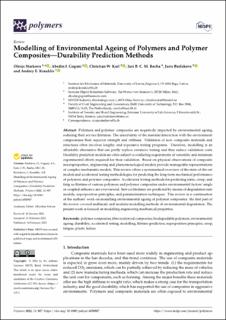| dc.contributor.author | Starkova, Olesja | |
| dc.contributor.author | Gagani, Abedin | |
| dc.contributor.author | Karl, Christian | |
| dc.contributor.author | Rocha, Iuri B. C. M. | |
| dc.contributor.author | Burlakovs, Juris | |
| dc.contributor.author | Krauklis, Andrejs | |
| dc.date.accessioned | 2022-06-17T07:10:20Z | |
| dc.date.available | 2022-06-17T07:10:20Z | |
| dc.date.created | 2022-03-01T11:09:37Z | |
| dc.date.issued | 2022 | |
| dc.identifier.citation | Polymers. 2022, 14 (5), 1-36. | en_US |
| dc.identifier.issn | 2073-4360 | |
| dc.identifier.uri | https://hdl.handle.net/11250/2999174 | |
| dc.description.abstract | Polymers and polymer composites are negatively impacted by environmental ageing, reducing their service lifetimes. The uncertainty of the material interaction with the environment compromises their superior strength and stiffness. Validation of new composite materials and structures often involves lengthy and expensive testing programs. Therefore, modelling is an affordable alternative that can partly replace extensive testing and thus reduce validation costs. Durability prediction models are often subject to conflicting requirements of versatility and minimum experimental efforts required for their validation. Based on physical observations of composite macroproperties, engineering and phenomenological models provide manageable representations of complex mechanistic models. This review offers a systematised overview of the state-of-the-art models and accelerated testing methodologies for predicting the long-term mechanical performance of polymers and polymer composites. Accelerated testing methods for predicting static, creep, and fatig ue lifetime of various polymers and polymer composites under environmental factors’ single or coupled influence are overviewed. Service lifetimes are predicted by means of degradation rate models, superposition principles, and parametrisation techniques. This review is a continuation of the authors’ work on modelling environmental ageing of polymer composites: the first part of the review covered multiscale and modular modelling methods of environmental degradation. The present work is focused on modelling engineering mechanical properties. | en_US |
| dc.language.iso | eng | en_US |
| dc.publisher | MDPI | en_US |
| dc.rights | Navngivelse 4.0 Internasjonal | * |
| dc.rights.uri | http://creativecommons.org/licenses/by/4.0/deed.no | * |
| dc.subject | Miljø | en_US |
| dc.subject | Environment | en_US |
| dc.subject | Polymerer | en_US |
| dc.subject | Polymers | en_US |
| dc.subject | Levetid | en_US |
| dc.subject | Service Lifetime | en_US |
| dc.subject | Matematisk modellering | en_US |
| dc.subject | Mathematical modelling | en_US |
| dc.subject | Aldring | en_US |
| dc.subject | Aging | en_US |
| dc.subject | Testing | en_US |
| dc.subject | Testing | en_US |
| dc.title | Modelling of environmental ageing of polymers and polymer composites—durability prediction methods | en_US |
| dc.title.alternative | Modelling of environmental ageing of polymers and polymer composites—durability prediction methods | en_US |
| dc.type | Peer reviewed | en_US |
| dc.type | Journal article | en_US |
| dc.description.version | publishedVersion | en_US |
| dc.rights.holder | Copyright: © 2022 by the authors. Licensee MDPI, Basel, Switzerland. This article is an open access article distributed under the terms and conditions of the Creative Commons Attribution (CC BY) license (https:// creativecommons.org/licenses/by/ 4.0/). | en_US |
| dc.subject.nsi | VDP::Matematikk og naturvitenskap: 400 | en_US |
| dc.subject.nsi | VDP::Mathematics and natural scienses: 400 | en_US |
| dc.source.pagenumber | 36 | en_US |
| dc.source.volume | 14 | en_US |
| dc.source.journal | Polymers | en_US |
| dc.source.issue | 5 | en_US |
| dc.identifier.doi | 10.3390/polym14050907 | |
| dc.identifier.cristin | 2006640 | |
| dc.relation.project | Norges forskningsråd: 310008 | en_US |
| dc.source.articlenumber | 907 | en_US |
| cristin.ispublished | true | |
| cristin.fulltext | original | |
| cristin.qualitycode | 1 | |

